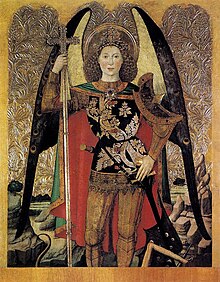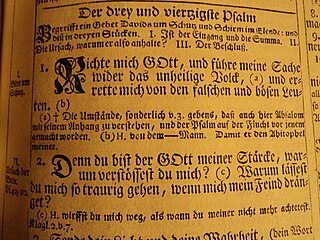
"Te Splendor" is a Roman Catholic hymn dedicated to Saint Michael, the Archangel. The hymn derives its name from the fact that in Latin it begins with the words: Te splendor et virtus Patris. The hymn is found in the Roman Breviary.

"Te Splendor" is a Roman Catholic hymn dedicated to Saint Michael, the Archangel. The hymn derives its name from the fact that in Latin it begins with the words: Te splendor et virtus Patris. The hymn is found in the Roman Breviary.
"Te splendor et virtus Patris" is based on the hymn "Tibi, Christe, splendor Patris" attributed to Rabanus Maurus, which was revised in 1632 by Pope Urban VIII. [1] [2] Many churches and religious orders continued to use the original version. [3]
In the Roman Breviary, "Te Splendor" is traditionally sung at Vespers and Matins on the Feast of St. Michael the Archangel (September 29), which also commemorates the Dedication of the Basilica of St. Michael the Archangel and all the Angels on Mount Gargano. (The apparition of St. Michael at Gargano is observed on May 8.) [4]
In 1817 Pope Pius VII granted an indulgence of 200 days once a day for saying the hymn (including antiphon and prayer) with a contrite heart and devotion, in honor of St. Michael the Archangel in order to obtain his patronage and protection against the assaults of the enemy of man. The hymn is included in the Raccolta collection of prayers, and its authorized translations. [5]
Tomás Luis de Victoria composed an arrangement of "Tibi Christe splendor patris". Palestrina arranged it as a hymn for four voices; Luca Marenzio set it as a motet. "Te Splendor et virtus Patris" forms a part of Marcel Dupré's "Le Tombeau de Titelouze" for organ.
English Catholic priest Frederick Charles Husenbeth did an English translation from the Latin, [6] as did Anglican priest and hymnwriter John Mason Neale in his 1867 Mediæval Hymns and Sequences. [7] Catholic Oratorian Edward Caswall's, translation is rendered as "O Jesu! Life-Spring of the Soul". [8]
English text of the hymn is as follows:
O Jesus, lifespring of the soul,
The Father's power, and glory bright!
Thee with the angels we extol;
From Thee they draw their life and light.
Thy thousand thousand hosts are spread
Embattled o‘er the azure sky;
But Michael bears Thy standard dread,
And lifts the mighty Cross on high.
He in that sign the rebel powers
Did with their dragon prince expel;
And hurl'd them from the heaven's high towers
Down like a thunderbolt to hell.
Grant us with Michael still, O Lord,
Against the Prince of Pride to fight;
So may a crown be our reward,
Before the Lamb's pure throne of light.
To God the Father glory be,
And to his sole-begotten Son;
The same, O Holy Ghost, to Thee,
While everlasting ages run.
Ant. Most glorious Prince, Michael the Archangel, be thou mindful of us; here, and in all places, pray for us to the Son of God most high.
V. I wilt sing praises to Thee, my God, before the Angels.
R. I will adore Thee in Thy holy temple, and praise Thy Name.
Let us pray.
O God, who in the dispensation of Thy providence dost admirably dispose the ministry of angels and of men; mercifully grant that the Holy Angels, who ever minister before Thy throne in heaven, may be the protectors also of our life on earth. Through Jesus Christ our Lord. [8]

Vespers is a liturgy of evening prayer, one of the canonical hours in Catholic, Eastern Orthodox, Oriental Orthodox, and Lutheran liturgies. The word for this prayer time comes from the Latin vesper, meaning "evening".

"Gloria in excelsis Deo" is a Christian hymn known also as the Greater Doxology and the Angelic Hymn/Hymn of the Angels. The name is often abbreviated to Gloria in Excelsis or simply Gloria.

The Angelus is a Catholic devotion commemorating the Incarnation of Christ. As with many Catholic prayers, the name Angelus is derived from its incipit—the first few words of the text: Angelus Domini nuntiavit Mariæ. The devotion is practised by reciting as versicle and response three Biblical verses narrating the mystery, alternating with the prayer "Hail Mary". The Angelus exemplifies a species of prayers called the "prayer of the devotee".
"Tantum ergo" is the incipit of the last two verses of Pange lingua, a Medieval Latin hymn composed by St Thomas Aquinas circa A.D. 1264. The "Genitori genitoque" and "Procedenti ab utroque" portions are adapted from Adam of Saint Victor's sequence for Pentecost. The hymn's Latin incipit literally translates to "Therefore so great".

The "Salve Regina", also known as the "Hail Holy Queen", is a Marian hymn and one of four Marian antiphons sung at different seasons within the Christian liturgical calendar of the Catholic Church. The Salve Regina is traditionally sung at Compline in the time from the Saturday before Trinity Sunday until the Friday before the first Sunday of Advent. The Hail Holy Queen is also the final prayer of the Rosary.

In Eastern Orthodox and Byzantine Catholic churches, an entrance is a procession during which the clergy enter into the sanctuary through the Holy Doors. The origin of these entrances goes back to the early church, when the liturgical books and sacred vessels were kept in special storage rooms for safe keeping and the procession was necessary to bring these objects into the church when needed. Over the centuries, these processions have grown more elaborate, and nowadays are accompanied by incense, candles and liturgical fans. In the liturgical theology of the Eastern Orthodox Church, the angels are believed to enter with the clergy into the sanctuary, as evidenced by the prayers which accompany the various entrances.
The Use of York or York Rite was a liturgical use of the Roman Rite – itself a Latin liturgical rite – practised in part of northern England, prior to the reign of Henry VIII. During Henry's reign the Use of York was suppressed in favour of the Use of Sarum, developed at Salisbury Cathedral, followed by the Book of Common Prayer. "Use" denotes the special liturgical customs which prevailed in a particular diocese or group of dioceses; it is one of the medieval English uses, together with the Use of Sarum, the Use of Hereford, and the Use of Bangor.
In Christian liturgical worship, Preces, also known in Anglican prayer as the Suffrages or Responses, describe a series of short petitions said or sung as versicles and responses by the officiant and congregation respectively. Versicle-and-response is one of the oldest forms of prayer in Christianity, with its roots in Hebrew prayer during the time of the Temple in Jerusalem. In many prayer books the versicles and responses comprising the Preces are denoted by special glyphs:
Veni Creator Spiritus is a traditional Christian hymn believed to have been written by Rabanus Maurus, a ninth-century German monk, teacher, archbishop, and saint. When the original Latin text is used, it is normally sung to a Gregorian Chant tune first known from Kempten Abbey around the year 1000. The hymn has been translated and paraphrased into several languages, and adapted into many musical forms, often as a hymn for Pentecost or for other occasions that focus on the Holy Spirit.
In liturgical use the term preface is a formal thanksgiving that immediately precedes the Canon, Eucharistic Prayer, Prayer of Consecration or analogous portion of the Eucharist. The preface, which begins at the words, "It is very meet and just, right and salutary" is ushered in, in all liturgies, with the Sursum corda and ends with the Sanctus.
"Adoro te devote" is a prayer written by Thomas Aquinas. Unlike hymns which were composed and set to music for the Solemnity of Corpus Christi, instituted in 1264 by Pope Urban IV for the entire Latin Church of the Catholic Church, it was not written for a liturgical function and appears in no liturgical texts of the period; some scholars believe that it was written by the friar for private use at Mass. The text has since been incorporated into public worship as a hymn.

Vesting prayers are prayers which are spoken while a cleric puts on vestments as part of a liturgy, in both the Eastern and Western churches. They feature as part of the liturgy in question itself, and take place either before or after a liturgical procession or entrance to the sanctuary, as depends on the particular liturgical rite or use which is being observed.

Catholic tradition and Mariology include specific prayers and devotions as acts of reparation for insults and blasphemies against Mary, mother of Jesus, often known as the Blessed Virgin Mary to Catholics. Similar prayers as Acts of Reparation to Jesus Christ and Acts of Reparation to The Holy Trinity also exist.

Te lucis ante terminum is an old Latin hymn in long metre. It is the hymn at Compline in the Roman Breviary.

Saint Michael the Archangel is referenced in the Old Testament and has been part of Christian teachings since the earliest times. In Catholic writings and traditions, he acts as the defender of the Church and the opponent of Satan. He also assists people at the hour of death.

Psalm 43 is the 43rd psalm of the Book of Psalms, known in the English King James Version as "Judge me, O God, and plead my cause against an ungodly nation". In the slightly different numbering system used in the Greek Septuagint and Latin Vulgate translations of the Bible, this psalm is Psalm 42. In Latin, it is known as "Iudica me Deus". It is commonly attributed to the sons of Korah. In the Hebrew Bible, it comes within the second of the five books (divisions) of Psalms, also known as the "Elohistic Psalter" because the word YHWH is rarely used and God is generally referred to as "Elohim".

Conditor alme siderum is a seventh-century Latin hymn used during the Christian liturgical season of Advent. It is also known in English as Creator of the Stars of Night, from a translation by J.M. Neale.
Attende, Domine is a Christian liturgical chant for the season of Lent, referred to in English as the Lent Prose matching Rorate caeli which is known as the Advent prose. The themes of this hymn are the sinfulness of man and the mercy of God, a theological concept emphasised during Lent.

Lucis Creator Optime is a 5th-century Latin Christian hymn variously attributed to St Gregory the Great or Saint Ambrose. It takes its title from its incipit.